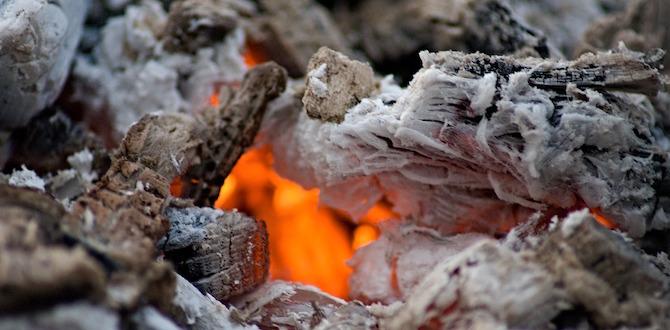Have you ever wondered what happens to wood when it burns? It turns into ashes, right? But did you know that wood ash is actually alkaline? This means it can change the pH level of soil. That might sound a bit complicated, but it’s super interesting!
Imagine you have a garden. You want your plants to grow big and strong. Adding wood ash can help because it improves the soil. But why is wood ash alkaline? This question leads us into a fascinating world of chemistry and nature.
Here’s a fun fact: wood ash comes from trees, which absorb minerals from the ground. When we burn wood, it turns into ash, leaving behind these helpful minerals. Isn’t it cool how something that seems like waste can help our gardens thrive?
In this article, we will explore the reasons why wood ash is alkaline. We’ll break it down into simple terms, so everyone can understand. Get ready to learn how you can use this surprising resource for your plants!
Table of Contents
Why Is Wood Ash Alkaline: Understanding Its Properties And Uses

Why is Wood Ash Alkaline
Wood ash becomes alkaline because it contains minerals like calcium carbonate. When trees burn, they leave behind ash that is rich in these basic compounds. This means that adding wood ash to soil can raise the pH level, making it less acidic. Have you ever wondered why some gardeners swear by wood ash? It’s a natural way to help plants thrive! However, too much can harm your soil’s balance. So, use it wisely for better gardening results.The pH Levels of Wood Ash
Explanation of how pH is measured and what qualifies as alkaline. Comparison of wood ash pH levels to other common materials.The pH scale measures acidity or alkalinity. It ranges from 0 to 14. A pH below 7 is acidic, while a pH above 7 is alkaline. Wood ash typically has a pH around 9 to 13, making it quite alkaline. To put this in perspective, let’s compare it to some common materials:
| Material | pH Level |
|---|---|
| Wood Ash | 9 – 13 |
| Neutral Water | 7 |
| Lemon Juice | 2 |
As you can see, wood ash is like the overachiever in pH school, proudly waving its alkaline flag! In fact, it’s more alkaline than many household items. Did you know that baking soda has a pH of about 8.4? Wood ash definitely gives it a run for its money!
Sources of Wood Ash and Variability in Alkalinity
Types of wood that produce different ash compositions. Factors affecting alkalinity, including burning temperature and wood moisture content.Different types of wood create various ash types. Hardwoods like oak make rich ash. Softwoods, such as pine, produce lighter ash. Burning temperature also affects ash composition. Higher temperatures lead to more alkaline ash. Another factor is wood moisture content. Drier wood produces better quality ash. Understanding these factors helps us appreciate the benefits of wood ash.
What affects wood ash alkalinity?
The alkalinity of wood ash can change due to several factors. These include:
- Type of wood burned
- Burning temperature
- Moisture content of the wood
Each of these influences the final quality of the ash and its uses.
Reactions of Wood Ash in Soil
How wood ash interacts with soil chemistry. Benefits of applying wood ash to gardens and lawns.Wood ash does some cool things in soil. It reacts with the soil, lifting the pH and making it more alkaline. This means plants can absorb nutrients better. Applying wood ash can lead to healthier gardens and lawns. Just sprinkle a little on the soil, and watch it work its magic! Did you know that one cup of wood ash can add about 0.5 pounds of potassium? That’s like giving your plants a special energy drink!
| Benefit | Description |
|---|---|
| Improves Soil | Increases pH levels, helping plants grow. |
| Nutrient Boost | Adds potassium and calcium, vital for plant health. |
| Pest Control | Can help keep some pests away. Goodbye, unwanted guests! |
Remember, moderation is key. Too much wood ash can cause problems. So, sprinkle wisely, and your garden will thank you!
Practical Applications of Wood Ash
Common uses in gardening, agriculture, and landscaping. Availability and methods for proper application of wood ash.Wood ash can be your garden’s secret weapon. It’s great for nutrient-rich soil and helps your plants grow strong. Many folks mix it into compost or spread it directly on the soil. Just sprinkle a thin layer over your garden beds. Plants like potatoes and tomatoes love the extra boost! Oh, and did you know it can keep pesky pests away too? They dislike the gritty texture—talk about a win-win!
| Application | Benefits |
|---|---|
| Composting | Adds nutrients |
| Soil amendment | Improves pH |
| Pest control | Deters insects |
Make sure to avoid using too much ash. A little goes a long way! Too much can mess with your soil’s balance. So, be the wise gardener and use it sparingly. Your plants will probably thank you with some happy dance moves! 🌱
Wood Ash vs. Other Alkaline Amendments
Comparison of wood ash with lime and other alkaline materials. Advantages and disadvantages of using wood ash in different scenarios.Wood ash stands out among alkaline amendments like lime. While lime has a strong, instant pH boost, wood ash offers a gentler, gradual effect. It’s like the tortoise in that famous race; slow and steady wins the soil health! Wood ash is rich in nutrients but may vary in its strength, depending on the type of wood burned. In some cases, it can be fantastic for gardens, while in others, it might lead to nutrient imbalance.
| Amendment | Advantages | Disadvantages |
|---|---|---|
| Wood Ash | Nutrient-rich and improves soil structure | Can be too variable in composition |
| Lime | Quickly raises soil pH | May cause a sudden spike in alkalinity |
| Baking Soda | Easy to apply | Slightly less effective over time |
Choosing wood ash can be like picking a favorite dessert. Sometimes you want chocolate cake, and sometimes a light sorbet! It’s all about matching the right amendment to your soil needs.
Conclusion
In summary, wood ash is alkaline because it contains minerals like calcium and potassium. These elements raise the pH level. Using wood ash can improve soil health by making it less acidic. If you garden, consider adding wood ash to your soil. For more details, check local gardening guides or talk to experienced gardeners. Happy gardening!FAQs
What Are The Main Chemical Components Of Wood Ash That Contribute To Its Alkalinity?Wood ash is made from burned trees. The main chemicals in wood ash are potassium, calcium, and magnesium. These chemicals make the ash alkaline, which means it can help neutralize acid. When you add wood ash to soil, it can make it healthier for plants.
How Does The Ph Level Of Wood Ash Compare To That Of Other Common Materials, Such As Garden Soil Or Limestone?Wood ash is usually more basic than many other materials. This means it has a higher pH level. Garden soil often has a lower pH, making it slightly acidic. Limestone also has a high pH, similar to wood ash. So, wood ash is good for making soil more balanced and healthy!
In What Ways Can The Alkaline Nature Of Wood Ash Be Beneficial For Gardening And Soil Health?Wood ash makes soil less acidic. This helps plants grow better. It adds important nutrients, like potassium and calcium, that plants need. You can sprinkle it on your garden to improve the soil’s health. Just remember not to use too much!
How Does The Alkalinity Of Wood Ash Vary Depending On The Type Of Wood Burned?The alkalinity of wood ash changes based on the type of wood you burn. Hardwoods, like oak or maple, usually make more alkaline ash. This means they can be more basic and can raise soil pH. Softwoods, like pine or fir, generally create less alkaline ash. So, the type of wood you use matters!
What Precautions Should Be Taken When Using Wood Ash In Landscaping Or Agricultural Applications Due To Its Alkaline Properties?When using wood ash, you should be careful because it’s very alkaline. Test the soil first to see if it needs ash. Don’t add too much, as it can make the soil too basic for plants. Always wear gloves to protect your hands. Finally, keep it away from sensitive plants that don’t like extra alkalinity.






